Topics
Category
Era
Bonanza Farms, Red River Valley
Bonanza farms—large, commercial farming enterprises that grew thousands of acres of wheat—flourished in northwestern Minnesota and the Dakotas from the 1870s to 1920. Geology, the Homestead Act of 1862, railroads, modern machinery, and revolutionary new flour-milling methods all contributed to the bonanza farm boom.
The fertile Red River Valley was created twelve thousand years ago when retreating glaciers left behind deposits of silt. The resulting flat land, with its rich topsoil, was well suited to farming with horsepower and machinery. The Homestead Act of 1862 enabled farmers to obtain 160 acres of land in exchange for a filing fee and a residency of five years. They could also purchase the property at a price of $1.25 per acre following six months of residency. This opportunity prompted an influx of European Americans into Dakota Territory and the new state of Minnesota.
Railroads had a significant impact on agricultural development in the Red River Valley. Trains provided transportation for the newcomers and carried equipment and supplies needed for farming. Railroad companies received large land grants to build their rail lines. One of the railroads, the Northern Pacific (NP), went into bankruptcy in 1873. The NP's board of directors agreed to exchange the railroad's worthless bonds for land at face value. This enabled investors to purchase large tracts of land for just fifteen cents per acre.
Among the first to take advantage of the offer of land at discounted prices were General George W. Cass, president of the NP, and Benjamin Cheney, a member of the railroad's board of directors. Cass and Cheney initially purchased 13,440 acres a few miles west of Fargo in 1874.
Absentee owners, often from the eastern United States or the Twin Cities, hired managers to oversee bonanza farm operations. Cass and Cheney hired Minnesota farmer Oliver Dalrymple to manage their farm. Its success ignited a firestorm of land sales to large-scale investors. By the early 1880s, speculators viewed the land of the Red River Valley as a gold mine.
Railway magnate James J. Hill also saw the advantage of owning land in the Red River Valley. Hill's interest in farming grew out of his desire to maximize his St. Paul, Minneapolis and Manitoba (later Great Northern) Railroad's profits. He reasoned that if the farmers along his rail lines were successful, his trains would have valuable freight to haul and would turn a tidy profit.
In 1881, Hill began purchasing land in Kittson County that had been a part of the railroad's original land grant at $2.75 per acre. His farm eventually totaled forty-five thousand acres (more than seventy square miles) and became the largest in Minnesota, although only about three thousand acres were under cultivation. To simplify management, in 1910 the farm was divided into two parts: the Humboldt and Northcote Divisions.
Most scholars agree that a farm had to have a minimum of three thousand acres to qualify as a "bonanza." While most such farms in Minnesota ranged from four thousand to ten thousand acres, others were immense. The Keystone Farm in Polk County took up 21,760 acres. The largest of all bonanza farms, the Cass-Cheney-Dalrymple farm in Dakota Territory, totaled seventy thousand acres.
Milling technology stimulated the growth of bonanza farms in the Red River Valley. Hard red spring wheat was more nutritious than winter wheat and better suited to the northern climate because it required a shorter growing period. Spring wheat's hard, brittle bran shell, however, made milling with the old-fashioned grindstone method more difficult. The millers in Minneapolis began to experiment with the "new process" of milling, using roller technology and middlings purifiers that could break down the hard shell and consistently produce large quantities of high-quality flour.
Modern farm machinery also boosted large-scale agriculture. Improved harrows and seed drills saved farmers time and labor. These machines sowed seeds at a predetermined, uniform depth and covered them to keep them from blowing away. This increased the chances that every seed would grow. Fanning mills cleaned grain prior to shipment, and cleaned seed wheat to eliminate noxious weeds. Self-tying binders saved the labor of bundling the grain by hand, although it was still hand-shocked. Improved steam traction engines and larger threshing machines made it possible to thresh huge volumes of grain.
Bonanza farms required fleets of equipment. In 1885, Hill's Humboldt Farm employed 254 horses and mules; forty-five each seeders, harrows, and binders; one hundred plows; six threshers; ninety-five wagons; fourteen mowers; and other small machinery. Not surprisingly, implement manufacturers sprang up in Minnesota to meet the needs of these farmers. The Minneapolis Threshing Machine Company (1887–1929) and the Northwest Thresher Company of Stillwater (1866–1913) are just two examples of businesses that grew out of the agricultural boom of the Red River Valley.
Typically, new acreage was broken in preparation for seeding each year, but not all of a bonanza farm's acreage was cultivated at once. Farmers intent upon making a quick fortune at the expense of the land continued to grow only wheat on the same acreage year after year. This depleted the nutrients in the soil and decreased yields. Severe weather, early and late frosts, too little or too much moisture, and insect and weed infestations all contributed to small yields and poor-quality grain.
Good harvests created a unique problem. Other countries, like Russia and Argentina, were also growing a substantial amount of wheat. The high volume of grain produced led to stiffer competition in the foreign market. This impacted the bonanza farm economy by driving down the price of wheat.
Some bonanza farm owners, like James J. Hill, saw the benefits of diversified farming and soil conservation through crop rotation. Hill put both into practice on his Humboldt Farm as an example to other farmers. Wheat was still king in the Red River Valley in the 1880s, but farmers began to dedicate some acres to other crops, such as oats, barley, and hay. They added cattle, sheep, and pigs—animals valued for the natural fertilizer they produced and as sources of food for the large crews required to run the farms.
By the end of the nineteenth century, most of the land in the Red River Valley was under cultivation. With fewer men needed in the spring to break the land, farm managers turned to migrant laborers. At times, finding enough men to work the land proved difficult. There was also some resistance on the part of local residents to the use of such labor; transient workers were perceived by some to be untrustworthy.
In the early twentieth century, bonanza farms fell victim to a number of factors, including the spread of diversification and increasing labor problems. It became more profitable to divide the land into smaller farms, and rising land prices led many to sell off acreage for a quick profit. Taxation also played a part in the demise of these colossal farms; an increase in taxes could wipe out the small margin of profit realized per acre. By 1920, most large-scale farming operations in the Red River Valley had ceased.
Bibliography
Bonanza Farms: Prairie Giants of the Northern Plains: The Bonanza Farm Story. VHS. Prairie Public Television, 2000.
"Bonanza Farming." St. Paul Daily Globe, May 16, 1885.
http://chroniclingamerica.loc.gov/lccn/sn90059522/1885-05-16/ed-1/seq-5
Department of Natural Resources. Natural History: Minnesota's Geology.
Originally found at http://www.dnr.state.mn.us/snas/naturalhistory.html
Dickman, Howard Leigh. "James Jerome Hill and the Agricultural Development of the Northwest." PhD diss., University of Michigan, 1977.
Drache, Hiram M. The Day of the Bonanza: A History of Bonanza Farming in the Red River Valley of the North. Fargo, ND: North Dakota Institute for Regional Studies, 1989. Reprint of the 1964 edition.
Holcombe, R.I., and William H. Bingham, eds. Compendium of History and Biography of Polk County, Minnesota. Minneapolis: W.H. Bingham, 1916.
Martin, Albro. James J. Hill and the Opening of the Northwest. St. Paul: Minnesota Historical Society Press, 1991.
Solum, Nancy, ed. Self Portrait of Marshall County: A History of One Minnesota County and the Many People Who Made that History. Dallas: Taylor Publishing, 1976.
Strom, Claire. "James J. Hill: Empire Builder as Farmer." Minnesota History 54, no. 6 (Summer 1995): 242–253.
http://collections.mnhs.org/MNHistoryMagazine/articles/54/v54i06p242-253.pdf
"Too Much Wheat." Little Falls Transcript, September 26, 1884.
http://chroniclingamerica.loc.gov/lccn/sn89064525/1884-09-26/ed-1/seq-8
Upham, Warren. Minnesota Place Names: A Geographical Encyclopedia. 3rd ed. St. Paul: Minnesota Historical Society Press, 2001.
Various. History of the Red River Valley, Past and Present: Including an Account of the Counties, Cities, Towns, and Villages of the Valley from the time of Their First Settlement and Formation. Vol. 2. Grand Forks, ND: Herald Print Office; Chicago: C.F. Cooper, 1909.
http://babel.hathitrust.org/cgi/pt?id=wu.89064492325;view=1up;seq=11
Woodward, Mary Dodge. The Checkered Years: A Bonanza Farm Diary 1884–1888. St. Paul: Minnesota Historical Society Press, 1989. Reprint of the 1937 edition.
Related Resources
Primary
"A Bonanza Wheat Farm. It Is So Extensive That the Various Crews of Workmen Never Meet." Mower County Transcript, November 24, 1897.
http://chroniclingamerica.loc.gov/lccn/sn85025431/1897-11-24/ed-1/seq-8
"Coming Our Way." Cook County Herald, September 30, 1905.
http://chroniclingamerica.loc.gov/lccn/sn90060625/1905-09-30/ed-1/seq-5/
"Farms Are Smaller. An Evidence That Rural Minnesotans Are Diversifying Crops. Bonanza Farms Being Cut Up." Minneapolis Journal, August 13, 1902.
http://chroniclingamerica.loc.gov/lccn/sn83045366/1902-08-13/ed-1/seq-11
Hill, James J. Highways of Progress. New York: Doubleday, Page & Company, 1909.
James J. Hill papers, 1823–1895 (bulk 1860–1916)
Manuscript Collection, Minnesota Historical Society, St. Paul
http://www2.mnhs.org/library/findaids/00698.xml#a8
Description: Humboldt and Northcote Farm Records, including correspondence and financial records, maps, and blueprints for Hill's Humbolt and Northcote farming operations.
McClain, N. W., and A.B. Stickney. "A Sermon on the Gospel of 'Mixed Farming', by 'an Ex-Bonanza Farmer.'" [N.p.: n.p., 1890?]. Copy in the Minnesota Historical Society Library.
Minneapolis Threshing Machine Company: Tenth Annual Catalogue. Minneapolis: The Company, [1896].
Minneapolis Threshing Machine Company: The Great Minneapolis Line, catalog. Hopkins, MN: The Company, 1907.
Minneapolis-Moline Company records, 1836–1982
Manuscript Collection, Minnesota Historical Society
http://www2.mnhs.org/library/findaids/00063.xml
Description: The collection includes correspondence and subject files, printed materials (sales brochures, product catalogs, price lists, and annual reports), clippings, patent information, corporate newsletters, some public relations department files, films, photographs, and tractor schematics.
Minnesota Thresher Manufacturing Company [a.k.a. Northwest Thresher Company], Catalogue and Price List of the Minnesota Thresher Manufacturing Company: Builder of Modern Threshing Machinery. Stillwater, MN: The Company, 1899.
Minnesota Thresher Manufacturing Company, Descriptive Catalog of Minnesota Chief Threshing Machinery. Stillwater, MN: [The Company, n.d.].
"N.P. Bonds. Hopes and Fears of the Bondholders." Bismarck Tribune, April 15, 1874.
http://chroniclingamerica.loc.gov/lccn/sn84022127/1874-04-15/ed-1/seq-7
"Profits of Bonanza Farming." Princeton Union, April 06, 1882.
http://chroniclingamerica.loc.gov/lccn/sn83016758/1882-04-06/ed-1/seq-5
"The Bonanza Farms; Demand for Land Causing Them to Be Cut Up.” Minneapolis Journal, February 11, 1902.
http://chroniclingamerica.loc.gov/lccn/sn84022127/1874-04-15/ed-1/seq-7
"What Will Follow." Bismarck Tribune, September 24, 1873.
http://chroniclingamerica.loc.gov/lccn/sn84022127/1873-09-24/ed-1/seq-2
"Wheat Raising." St. Paul Daily Globe, April 24, 1886.
http://chroniclingamerica.loc.gov/lccn/sn90059522/1886-04-24/ed-1/seq-9
Secondary
Drache, Hiram M. The Challenge of the Prairie: Life and Times of Red River Pioneers. Fargo: North Dakota Institute for Regional Studies, 1970.
Folwell, William Watts. A History of Minnesota. Vol. 3. St. Paul: Minnesota Historical Society, 2004. Reprint of 1969 edition.
McLain, N.W. "Diversified Farming in Minnesota." [N.p.: n.p., 1890?]. Copy in the Minnesota Historical Society Library.
Strom, Claire Margaret. Profiting from the Plains: the Great Northern Railway and Corporate Development of the American West. Seattle: University of Washington Press, 2003.
——— . "Unattainable Edens: James J. Hill, the Great Northern Railway and Changing Notions of Agricultural Expertise." PhD diss., Iowa State University, 1998.
Web
Bagg Bonanza Farm Historic Site.
Originally found at http://baggbonanzafarm.org/
Fargo History Project. Oliver Dalrymple.
http://fargohistory.com/oliver-dalrymple/
Farm Collector. Prison-Made Steam Engines: The Northwest Thresher Company Began with Minnesota Prison Labor.
http://www.farmcollector.com/company-history/northwest-thresher-company-began-with-minnesota-prison-labor.aspx?PageId=4
North Dakota State University Archives, Fargo, North Dakota: Its History and Images, Bonanza Farms.
http://library.ndsu.edu/fargo-history/?q=content/bonanza-farms
North Dakota State University Archives, Fargo, North Dakota: Its History and Images, Dalrymple Farm.
http://library.ndsu.edu/fargo-history/?q=content/dalrymple-farm
Related Images
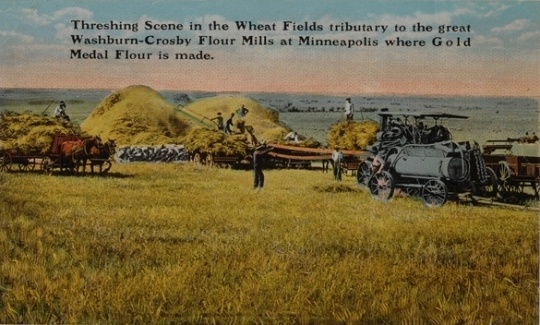
Washburn-Crosby Flour Mills advertisement for Gold Medal Flour, Threshing Scene
Washburn-Crosby Flour Mills advertisement for Gold Medal Flour, Threshing Scene, c.1900.
Public domain
Holding Location
Articles
More Information
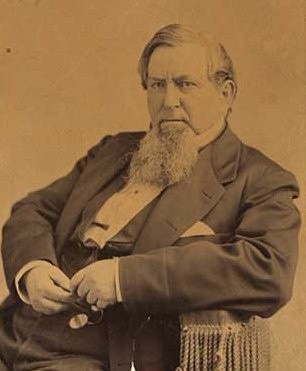
George W. Cass
George W. Cass, c.1875.
Public domain
Holding Location
Articles
More Information
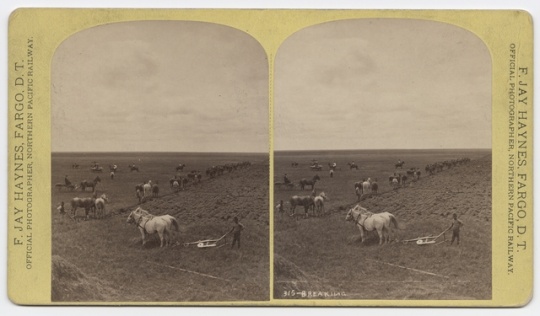
Breaking ground along the line of the Northern Pacific Railroad at Dalrymple Farm
Breaking ground along the line of the Northern Pacific Railroad at Dalrymple Farm, twenty miles west of Fargo, 1878. Photograph by Frank Jay Haynes.
Public domain
Holding Location
More Information

Threshing scene at the Lockhart farm, Norman County
Threshing scene at the Lockhart farm, Norman County, Minnesota, 1885. Photograph by Mrs. C. P. Cahoon.
Public domain
Holding Location
Articles
More Information
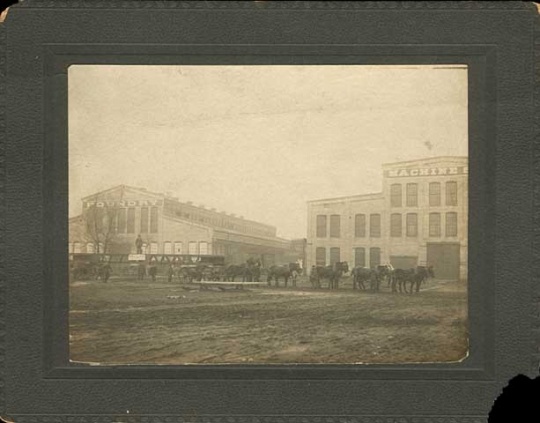
Minneapolis-Moline, Lake Street and Minnehaha, Minneapolis
Minneapolis-Moline, Lake Street and Minnehaha, Minneapolis, c.1895.
Public domain
Holding Location
Articles
More Information

Threshing on the James J. Hill farm, Northcote
Threshing on the James J. Hill farm, Northcote, c.1900. Photograph by A.H. Anderson.
Public domain
Holding Location
Articles
More Information
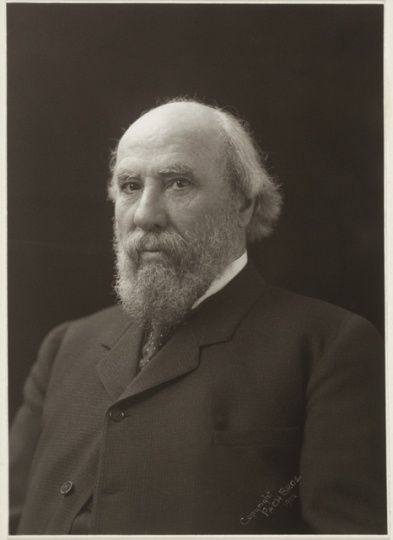
James J. Hill
James J. Hill, 1902. Photograph by Pach Brothers.
Public domain
Holding Location
More Information
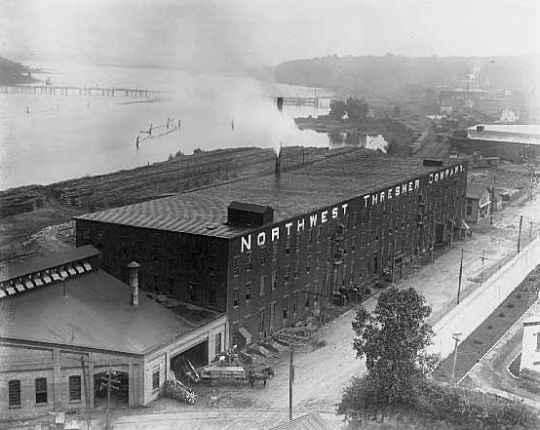
Northwest Thresher Company, Stillwater
Northwest Thresher Company, Stillwater, 1907. Photograph by John Runk Jr.
Public domain
Holding Location
Articles
More Information

Minneapolis Threshing Machine Company Plant, Hopkins
Minneapolis Threshing Machine Company Plant, Hopkins, 1908.
Public domain
Holding Location
Articles
More Information
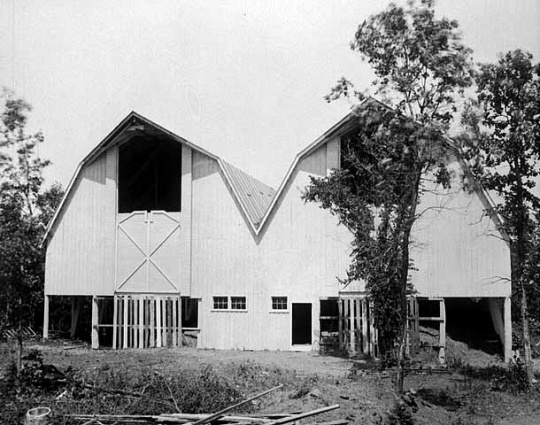
Northcote Farm, Kittson County
Northcote Farm, Kittson County, c.1910. Photograph by William Hartvig.
Public domain
Holding Location
Articles
More Information
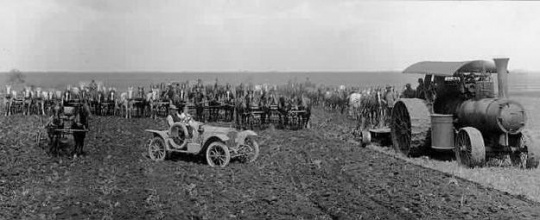
Men, horses, farm implements in field, Northcote farm
Men, horses, farm implements in field, Northcote farm, Northcote, Minnesota, 1914. Photograph by William Hartvig.
Public domain
Holding Location
Articles
More Information
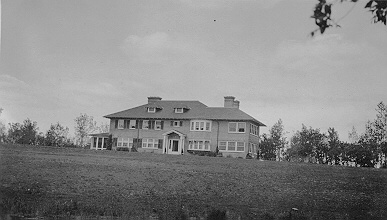
Walter J. Hill's Northcote Farm Residence
Walter J. Hill's Northcote Farm Residence, 1915. Photograph by D. Wallace.
Public domain
Holding Location
Articles
More Information
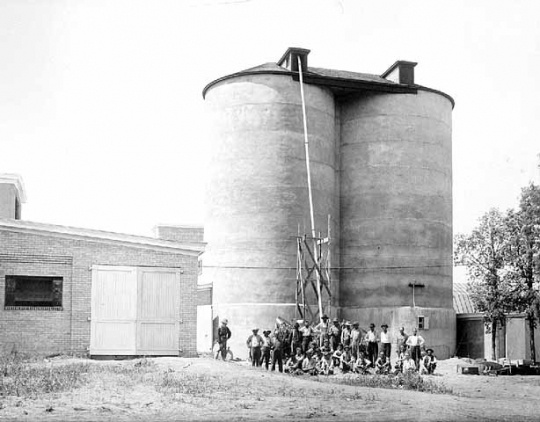
Northcote Farm, in Kittson County
Northcote Farm, Kittson County, c.1910. Photograph by William Hartvig.
Public domain
Holding Location
Articles
More Information
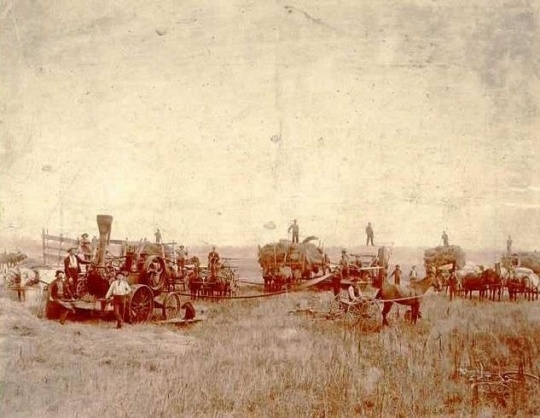
Unidentified men in field with farm machinery, James J. Hill's Northcote Farm
Unidentified men in field with farm machinery, James J. Hill's Northcote Farm, Northcote, Minnesota, undated.
Holding Location
Articles
More Information
Related Articles
Turning Point
The default of the Northern Pacific Railway in 1873, which leads to a fire sale of the company's fertile farmland in northwestern Minnesota and Dakota Territory, initiates the growth of large-scale "bonanza" farms.
Chronology
10,000 BCE
1862
1873
1874
1880
1880s
1881
Late 1890s
Early 1900s
1920
Bibliography
Bonanza Farms: Prairie Giants of the Northern Plains: The Bonanza Farm Story. VHS. Prairie Public Television, 2000.
"Bonanza Farming." St. Paul Daily Globe, May 16, 1885.
http://chroniclingamerica.loc.gov/lccn/sn90059522/1885-05-16/ed-1/seq-5
Department of Natural Resources. Natural History: Minnesota's Geology.
Originally found at http://www.dnr.state.mn.us/snas/naturalhistory.html
Dickman, Howard Leigh. "James Jerome Hill and the Agricultural Development of the Northwest." PhD diss., University of Michigan, 1977.
Drache, Hiram M. The Day of the Bonanza: A History of Bonanza Farming in the Red River Valley of the North. Fargo, ND: North Dakota Institute for Regional Studies, 1989. Reprint of the 1964 edition.
Holcombe, R.I., and William H. Bingham, eds. Compendium of History and Biography of Polk County, Minnesota. Minneapolis: W.H. Bingham, 1916.
Martin, Albro. James J. Hill and the Opening of the Northwest. St. Paul: Minnesota Historical Society Press, 1991.
Solum, Nancy, ed. Self Portrait of Marshall County: A History of One Minnesota County and the Many People Who Made that History. Dallas: Taylor Publishing, 1976.
Strom, Claire. "James J. Hill: Empire Builder as Farmer." Minnesota History 54, no. 6 (Summer 1995): 242–253.
http://collections.mnhs.org/MNHistoryMagazine/articles/54/v54i06p242-253.pdf
"Too Much Wheat." Little Falls Transcript, September 26, 1884.
http://chroniclingamerica.loc.gov/lccn/sn89064525/1884-09-26/ed-1/seq-8
Upham, Warren. Minnesota Place Names: A Geographical Encyclopedia. 3rd ed. St. Paul: Minnesota Historical Society Press, 2001.
Various. History of the Red River Valley, Past and Present: Including an Account of the Counties, Cities, Towns, and Villages of the Valley from the time of Their First Settlement and Formation. Vol. 2. Grand Forks, ND: Herald Print Office; Chicago: C.F. Cooper, 1909.
http://babel.hathitrust.org/cgi/pt?id=wu.89064492325;view=1up;seq=11
Woodward, Mary Dodge. The Checkered Years: A Bonanza Farm Diary 1884–1888. St. Paul: Minnesota Historical Society Press, 1989. Reprint of the 1937 edition.
Related Resources
Primary
"A Bonanza Wheat Farm. It Is So Extensive That the Various Crews of Workmen Never Meet." Mower County Transcript, November 24, 1897.
http://chroniclingamerica.loc.gov/lccn/sn85025431/1897-11-24/ed-1/seq-8
"Coming Our Way." Cook County Herald, September 30, 1905.
http://chroniclingamerica.loc.gov/lccn/sn90060625/1905-09-30/ed-1/seq-5/
"Farms Are Smaller. An Evidence That Rural Minnesotans Are Diversifying Crops. Bonanza Farms Being Cut Up." Minneapolis Journal, August 13, 1902.
http://chroniclingamerica.loc.gov/lccn/sn83045366/1902-08-13/ed-1/seq-11
Hill, James J. Highways of Progress. New York: Doubleday, Page & Company, 1909.
James J. Hill papers, 1823–1895 (bulk 1860–1916)
Manuscript Collection, Minnesota Historical Society, St. Paul
http://www2.mnhs.org/library/findaids/00698.xml#a8
Description: Humboldt and Northcote Farm Records, including correspondence and financial records, maps, and blueprints for Hill's Humbolt and Northcote farming operations.
McClain, N. W., and A.B. Stickney. "A Sermon on the Gospel of 'Mixed Farming', by 'an Ex-Bonanza Farmer.'" [N.p.: n.p., 1890?]. Copy in the Minnesota Historical Society Library.
Minneapolis Threshing Machine Company: Tenth Annual Catalogue. Minneapolis: The Company, [1896].
Minneapolis Threshing Machine Company: The Great Minneapolis Line, catalog. Hopkins, MN: The Company, 1907.
Minneapolis-Moline Company records, 1836–1982
Manuscript Collection, Minnesota Historical Society
http://www2.mnhs.org/library/findaids/00063.xml
Description: The collection includes correspondence and subject files, printed materials (sales brochures, product catalogs, price lists, and annual reports), clippings, patent information, corporate newsletters, some public relations department files, films, photographs, and tractor schematics.
Minnesota Thresher Manufacturing Company [a.k.a. Northwest Thresher Company], Catalogue and Price List of the Minnesota Thresher Manufacturing Company: Builder of Modern Threshing Machinery. Stillwater, MN: The Company, 1899.
Minnesota Thresher Manufacturing Company, Descriptive Catalog of Minnesota Chief Threshing Machinery. Stillwater, MN: [The Company, n.d.].
"N.P. Bonds. Hopes and Fears of the Bondholders." Bismarck Tribune, April 15, 1874.
http://chroniclingamerica.loc.gov/lccn/sn84022127/1874-04-15/ed-1/seq-7
"Profits of Bonanza Farming." Princeton Union, April 06, 1882.
http://chroniclingamerica.loc.gov/lccn/sn83016758/1882-04-06/ed-1/seq-5
"The Bonanza Farms; Demand for Land Causing Them to Be Cut Up.” Minneapolis Journal, February 11, 1902.
http://chroniclingamerica.loc.gov/lccn/sn84022127/1874-04-15/ed-1/seq-7
"What Will Follow." Bismarck Tribune, September 24, 1873.
http://chroniclingamerica.loc.gov/lccn/sn84022127/1873-09-24/ed-1/seq-2
"Wheat Raising." St. Paul Daily Globe, April 24, 1886.
http://chroniclingamerica.loc.gov/lccn/sn90059522/1886-04-24/ed-1/seq-9
Secondary
Drache, Hiram M. The Challenge of the Prairie: Life and Times of Red River Pioneers. Fargo: North Dakota Institute for Regional Studies, 1970.
Folwell, William Watts. A History of Minnesota. Vol. 3. St. Paul: Minnesota Historical Society, 2004. Reprint of 1969 edition.
McLain, N.W. "Diversified Farming in Minnesota." [N.p.: n.p., 1890?]. Copy in the Minnesota Historical Society Library.
Strom, Claire Margaret. Profiting from the Plains: the Great Northern Railway and Corporate Development of the American West. Seattle: University of Washington Press, 2003.
——— . "Unattainable Edens: James J. Hill, the Great Northern Railway and Changing Notions of Agricultural Expertise." PhD diss., Iowa State University, 1998.
Web
Bagg Bonanza Farm Historic Site.
Originally found at http://baggbonanzafarm.org/
Fargo History Project. Oliver Dalrymple.
http://fargohistory.com/oliver-dalrymple/
Farm Collector. Prison-Made Steam Engines: The Northwest Thresher Company Began with Minnesota Prison Labor.
http://www.farmcollector.com/company-history/northwest-thresher-company-began-with-minnesota-prison-labor.aspx?PageId=4
North Dakota State University Archives, Fargo, North Dakota: Its History and Images, Bonanza Farms.
http://library.ndsu.edu/fargo-history/?q=content/bonanza-farms
North Dakota State University Archives, Fargo, North Dakota: Its History and Images, Dalrymple Farm.
http://library.ndsu.edu/fargo-history/?q=content/dalrymple-farm















